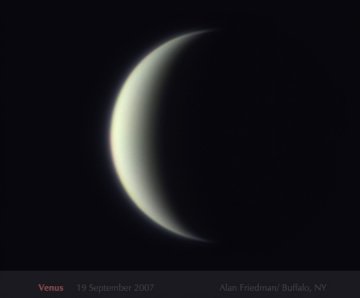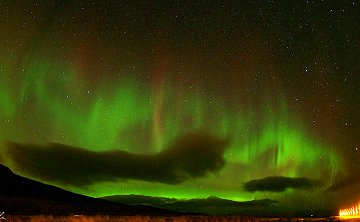 Where's Saturn? Is that a UFO--or the ISS? What's the name of that star? Get the answers from mySKY--a fun new astronomy helper from Meade. . Where's Saturn? Is that a UFO--or the ISS? What's the name of that star? Get the answers from mySKY--a fun new astronomy helper from Meade. . PROMINENCE ALERT: Amateur astronomer Stephen Ames of Hodgenville, Kentucky, reports that a "huge prominence" is on display over the north limb of the sun. Observers, if you have a solar telescope, please take a look. images: from J. Gormley, B. Harrington and John Stetson of South Portland, Maine MORNING GODDESS: "I rose early this morning to observe Mars, but I became entranced by Venus blazing in the eastern sky and turned my camera there instead," says Alan Friedman of Buffalo, New York. This is the photo he took using his 10-inch telescope: 
Like the Moon, Venus has phases, and at the moment she has assumed the form of a slender crescent. "The only planet named for a goddess is as beautiful as she is mysterious," says Friedman. This week the morning goddess reaches maximum brightness. Shining at visual magnitude -4.5, Venus is 10 times brighter than Jupiter and 16 times brighter than Sirius--the brightest star in the heavens! No sky map is required to find Venus. Before dawn, simply look east for the brilliant light. AURORA WATCH: There was no geomagnetic storm in Iceland last week. But no special storm is necessary for Icelandic auroras, because the Northern island is located so close to Earth's auroral oval. Marco Fulle of Nesjavellir, Iceland, snapped this picture on Sept. 13th: 
Photo details: Fuji Finepix S3, ISO 800, Nikkor fisheye lens, 30sec exp
The auroral oval is a circular "doughnut" of nearly non-stop Northern Lights ringing Earth's north pole. (The south pole has its own oval of Southern Lights.) Normally, the oval remains deep in the Arctic, but gusts of solar wind hitting Earth can cause it to expand. A mild gust produced the Icelandic display pictured above. A much stronger gust is due on Sept. 22nd; its impact could spark a full-fledged magnetic storm and push the oval across Canada to northern-tier states such as Wisconsin and Minnesota. Sky watchers, be alert for auroras! September 2007 Aurora Gallery
[August 2007 Aurora Gallery] [Aurora Alerts] | 
